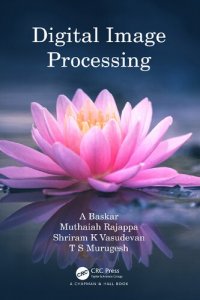
Ebook: Digital Image Processing,
- Genre: Computers // Algorithms and Data Structures: Pattern Recognition
- Year: 2023
- Publisher: CRC Press
- Edition: 1
- Language: English
- pdf
The book provides a mix of theoretical and practical perceptions of the related concepts pertaining to image processing. The primary objectives are to offer an overview to the elementary concepts and practices appropriate to digital image processing as well as to provide theoretical exposition. It starts with an expanded coverage of the fundamentals to provide a more comprehensive and cohesive coverage of the topics including but not limited to:
Applications and tools for image processing, and fundamentals with several implementation examples
Concepts of image formation
OpenCV installation with step-by-step screen shots
Concepts behind intensity, brightness and contrast, color models
Ways by which noises are created in an image and the possible remedial measures
Edge detection, image segmentation, classification, regression, classification algorithms
Importance of frequency domain in image processing field
Relevant code snippets and the MATLAB codes, and several interesting sets of simple programs in OpenCV and Python to aid learning and for complete understanding
You have been exposed to image processing concepts in an extensive manner throughout this book and we hope it has been an enjoyable learning experience. For the cherry on top, this chapter shows how to play around with OpenCV and Python. An interesting set of simple programs to help enhance understanding is presented. The codes in this chapter are written in Python and run in Ubuntu as the base. Any recent version of Ubuntu should be handy and one can install Ubuntu alongside the Windows operating system. The readers are requested to install Ubuntu as presented next step-by-step. The first step is to install the OpenCV in the Ubuntu. Remember, OpenCV is not a programming language, it is a package. We are going to use Python with OpenCV, and hence we have to import OpenCV in all the programs that are to be demonstrated shortly in the chapter.
The video lectures for specific topics through YouTube enable easy inference for the readers to apply the learnt theory into practice. The addition of contents at the end of each chapter such as quizzes and review questions fully prepare the readers for further study.
Graduate students, post graduate students, researchers, and anyone in general interested in image processing, computer vision, machine learning domains etc. can find this book an excellent starting point for information and an able ally.
Applications and tools for image processing, and fundamentals with several implementation examples
Concepts of image formation
OpenCV installation with step-by-step screen shots
Concepts behind intensity, brightness and contrast, color models
Ways by which noises are created in an image and the possible remedial measures
Edge detection, image segmentation, classification, regression, classification algorithms
Importance of frequency domain in image processing field
Relevant code snippets and the MATLAB codes, and several interesting sets of simple programs in OpenCV and Python to aid learning and for complete understanding
You have been exposed to image processing concepts in an extensive manner throughout this book and we hope it has been an enjoyable learning experience. For the cherry on top, this chapter shows how to play around with OpenCV and Python. An interesting set of simple programs to help enhance understanding is presented. The codes in this chapter are written in Python and run in Ubuntu as the base. Any recent version of Ubuntu should be handy and one can install Ubuntu alongside the Windows operating system. The readers are requested to install Ubuntu as presented next step-by-step. The first step is to install the OpenCV in the Ubuntu. Remember, OpenCV is not a programming language, it is a package. We are going to use Python with OpenCV, and hence we have to import OpenCV in all the programs that are to be demonstrated shortly in the chapter.
The video lectures for specific topics through YouTube enable easy inference for the readers to apply the learnt theory into practice. The addition of contents at the end of each chapter such as quizzes and review questions fully prepare the readers for further study.
Graduate students, post graduate students, researchers, and anyone in general interested in image processing, computer vision, machine learning domains etc. can find this book an excellent starting point for information and an able ally.
Download the book Digital Image Processing, for free or read online
Continue reading on any device:

Last viewed books
Related books
{related-news}
Comments (0)